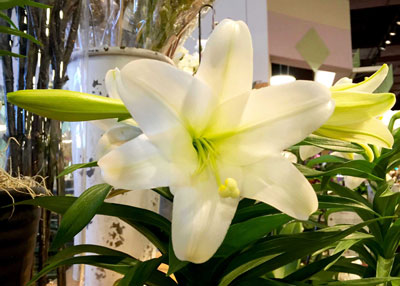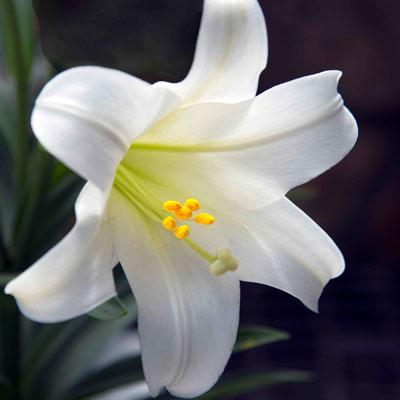Appreciate the Lily Grower
It’s always been standard practice to make one or two runs to the grocery to pick up things for a big Easter feast. But our feast will be different because we’re buying curbside. And that means we aren’t strolling past the beautiful Easter lilies this year. That makes me sad.

My heart goes out to the men and women who raise Easter lilies, most especially in this challenging year. Churches all over America have cancelled their orders – there’s no one inside to see them adorning the altars.
Hopefully, however, you’ll swing curbside by a nursery or grocery near you and have them bring one out to your car. It just wouldn’t be Easter without one. But let me tell you a bit about them.
Maximizing your lily…
You may have gotten your plant sleeved in a brown paper wrap to protect it. We’ll start there.
1. If it is sleeved, remove the sleeve from the bottom up, carefully tearing it away. Our instinct is to try to save the sleeve. Trust me – you have absolutely no reason to do so
2. Keep your plant moist, bright and cool – just as it was in the greenhouse. Do no leave it standing in water, however.
3. As the individual flowers just start to open, carefully pinch off the anthers (flower parts that contain pollen) with tweezers. The pollen will stain the petals, and it’s sticky.

4. When the plant has finished blooming, plant it into your perennial garden. It will do best in morning sun with afternoon shade. It will bloom again next year – probably a few weeks after Easter, but don’t be surprised if it plays out after a few years due primarily to the Texas summertime heat.
Why some growers don’t like lilies…
Easter lilies are the all-time gamble of commercial gardening. They have no way of knowing what to expect. Here’s why:
• Unlike all other holidays, the date of Easter can vary by almost a full month from late March past the middle of April. Compare that to poinsettias, for example. Christmas is almost always on the same date.
• Spring conditions vary from year to year. So it’s really hard for a grower to learn where the plants should be in their development on any given date. Things are never the same.
• Lilies are grown from bulbs, and quality of those bulbs can vary – much more than cuttings or seeds of other greenhouse crops.
• Those bulbs are produced primarily in the Northwestern U.S., and conditions there are cool and moist. But their weather varies from one year to the next, too.
• Bulbs are expensive – much more so than starter plants for most other florist crops.
• Lilies are usually planted into their greenhouse pots as soon as poinsettias are cleared out. But remember that the end date for the lily crop varies by 25 days one year to the next.
• The grower uses temperature to control the plants’ rate of development: warmer to speed them up, cooler to slow them down.
• Lilies are sold by bud count. The more buds a plant has, the better the price the grower will get for it.
• But if you change the temperatures too much as the plants are growing, or if you let the plants get just a tiny bit too dry, buds will abort (“blast”) and the value of the plant is sure to sink.
• In their pots and with their potting soils, lilies are heavy to ship, and flower buds are easily snapped. And there go the profits.
• And, as if all that weren’t enough, along comes a year with a pandemic when churches are closed and when folks are afraid to go into stores where they’d be likely to pick up a lily on impulse. Oh, good luck to those growers. How we hope they come out of this solvent!
